Holy Cow! Bovines Starve to Death, Dogs Gnaw Their Bodies in 2 UP Shelters
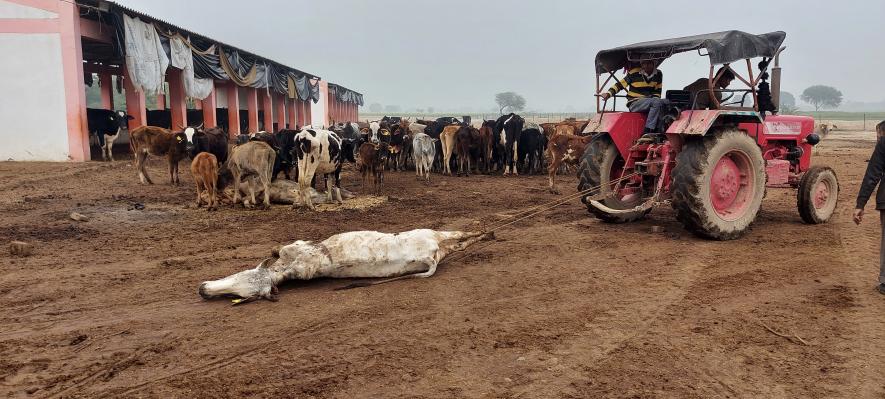
Etah (Uttar Pradesh): Gut-wrenching scenes of dead bovines being savagely dragged away for burial only to be left later for a pack of dogs to feast on and others starving to death at two gaushalas (cow shelters) in Uttar Pradesh (UP), which has prioritised protecting cows under its saffron-clad chief minister Yogi Adityanath, exposes the reality behind the facade of the communally charged gau raksha (cow protection) campaign.
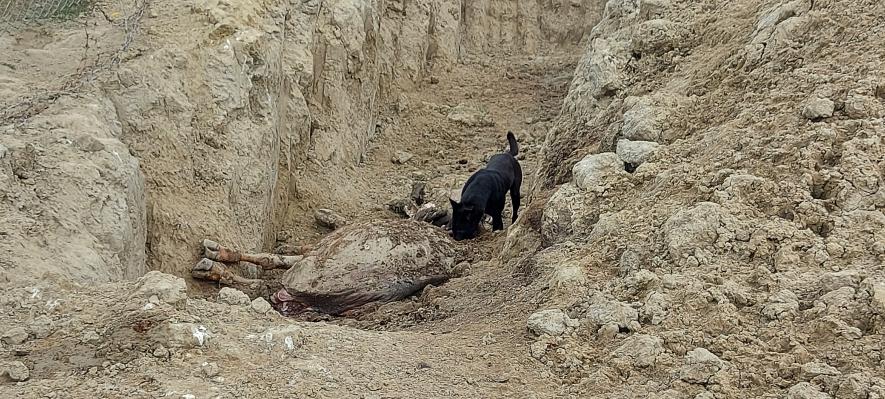
Exposed to the extreme cold in the open sheds, some cows die while the other emaciated ones are somehow surviving on an irregular supply of husk, not the necessary nutritious green fodder, according to the caretakers.
At the overcrowded Vrihad Gau Sanrakshan Kendra, located at Wahid Bibipur village, in Sakit Block, four cows are dead—two of the bodies are being savagely dragged one by one by a tractor from inside a tin shed meant to store fodder to nearby pits; the other two lie in the open. The sight of packs of dogs gnawing the decomposing bodies in the pits is common with the filthy stench pervading the air.
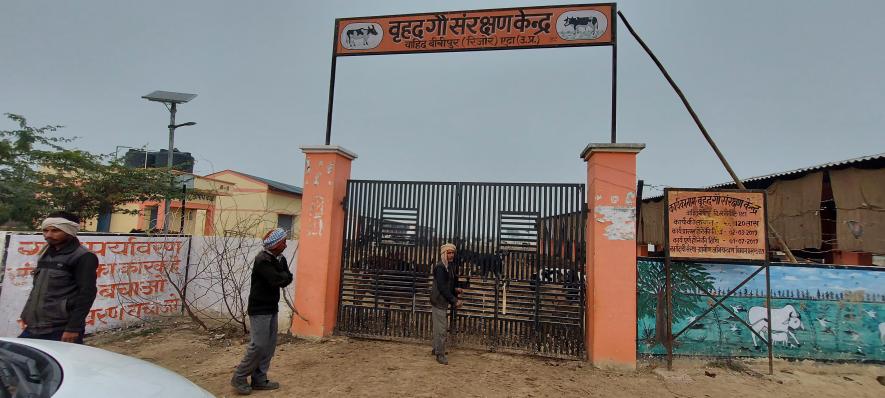
“The shelter has become overcrowded with people daily leaving stray cattle. We have no option but to admit them despite the lack of space. The cows are fed only husk in a gap of three to four days,” Mahesh Gupta, one of the men employed by the shelter, tells Newsclick. When Gupta apprised the Panchayat secretary of the shortage of fodder, he was told that “fund is awaited”.
Sick cows die an agonising death due to the lack of required medicines at the dispensary. “The vet examines the sick cows daily but he cannot do much to save the dying ones due to the dearth of required medicines,” says Amit Agarwal, one of the men guarding the shelter, adding, “the situation is pathetic.”
The situation of the staff is not good either with the salaries pending for months. “Four employees, including me, have been paid Rs 6,000 only once in the past five months despite working round the clock,” says Gupta.
The Etah tehsildar did not respond to repeated calls while the cell phone of the secretary was switched off.
According to the 2019 livestock survey, stray cattle increased by 117% after Adityanath banned the bovine trade. Farmers in the state are facing the worst stray cattle menace following the ban. Trading in cattle came to a halt because of alleged police harassment and attacks by cow vigilante groups.
When they stop producing milk and become infertile, the cows are abandoned by cattlemen. The abandoned cattle raid agricultural fields in search of fodder causing huge losses to farmers, who spend chilly nights in the open guarding their crops. Besides, stray cattle pose a risk to humans with the recent increase in bull attacks.
Ashok Kumar, who owns five acres in Rajkot village, alleges when farmers go to gaushalas with stray cattle, they are asked to pay Rs 1,100 as their contribution to cow protection. “The gaushalas free the stray cattle due to lack of space,” he tells Newsclick. “Farmers chasing away stray cattle from their fields are slapped with FIRs if anyone complains to the police. One FIR was also filed against me for attacking a cow while chasing it away from my field,” he says.
The cattle menace has become so alarming that enraged farmers often fight among themselves with reported incidents of firing, according to former Army man Dalvir Singh. “When a farmer chases a herd of stray cows from his field, they scurry to the adjacent plot, enraging its owner. Sometimes, it leads to clashes, including firing,” he says.
Singh alleged that the state government is, in fact, indulging in “gau hatya (killing of cows)” in the name of gau raksha. “If the government is unable to run the shelters, it should hand them over to us. We are farmers. We will take care of them,” he adds.
Himmat Singh Katheria, who owns 1.2 acres in Akbarpur Aunchha, in Mainpuri district’s Kuraoli Block, commented in a similar vein. “If the government really wants to protect cows, it should honestly manage the gaushalas. We are ready to contribute to it,” he says adding, “stray cattle are a double whammy for the farmers, who don’t get proper prices for their produce.”
Spread on 23.6 acres, the gaushala at Nagla Hari, a small hamlet in Basrehar Block of Etawah district, is no different.
Jam-packed with more than 500 cows, the shelter can only accommodate 475, its caretakers say alleging insufficient supply of fodder.
“Only Rs 30 is allocated for each cow per day. The amount is too small to meet their daily food requirement, especially green fodder. We try our best to feed them husk daily but it’s in short supply. The cows are starved and weak,” Amit, one of seven employees of the shelter, tells Newsclick. “The shelter has not been constructed in a way to protect the animals from such harsh weather,” he says adding, “these are the two reasons for the daily deaths.”
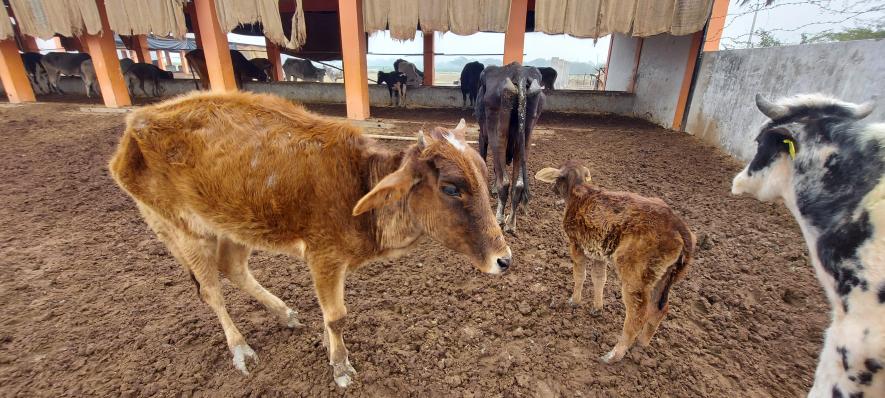
The villagers allege that they are turned away by the shelter when they land there with stray cattle. According to Amit, the village head and the Panchayat secretary have instructed the shelter not to accept more cows. When asked about their “instructions”, the head and the secretary claimed “all is well” and asked the reporter to not believe “rumours”.
The huge shelter has an area earmarked for burying dead cows with body parts poking out of several graves confirming the allegations of villagers that cattle are dying in large numbers daily due to starvation and the harsh weather. Though the caretakers deny cows dying daily, they are mum when asked about the new graves.
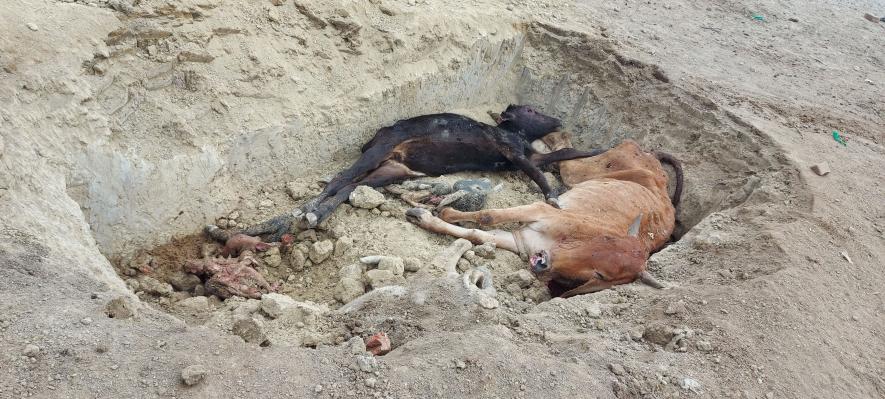
The ground reality appears quite different from the state government’s claim of establishing 3,458 bhoosa (fodder) banks across the districts and arranging 8.87 lakh quintal of fodder for the animals.
According to government figures, the state has 5,384 Gau Sanrakshan Kendras, housing 6.50 lakh cow progeny. The state, as per the 2019 livestock survey, has around 1.16 million stray cattle. Out of these, about 750,000 are either in shelters or adopted as part of a state government scheme.
Sudhir Garg, principal secretary, animal husbandry department, had said in November last year that the state government aims to rehabilitate nearly 4 lakh stray cattle over the next two months and deploy cattle catchers at the block level to bring the animals to the shelters.
The names of the employees of the cow shelters have been changed to protect their identities.
Get the latest reports & analysis with people's perspective on Protests, movements & deep analytical videos, discussions of the current affairs in your Telegram app. Subscribe to NewsClick's Telegram channel & get Real-Time updates on stories, as they get published on our website.
























